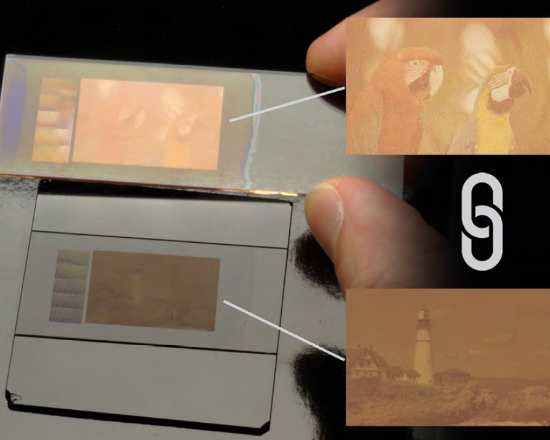Article: Photoniques, Trois images en une : comment la nanophotonique révolutionne le concept d’image imprimée
Photoniques, the journal of the Société Française d’Optique, is a bimonthly publication dedicated entirely to optical solutions, encompassing both their design and application. In March 2024, an article by researchers from our Functional Materials & Surfaces and Image Science & Computer Vision teams was published, providing a retrospective on their collaborative work with the company HID Global CID.
Trois images en une : comment la nanophotonique révolutionne le concept d’image imprimée
N. Dalloz, M. Hebert, N. Destouches
For thousands of years, techniques for producing color images have primarily relied on applying colored materials to opaque surfaces that reflect colored light back to the observer. These images are designed to display a single, stable image with colors that remain relatively unchanged, regardless of the viewing angle or lighting.
In the last few decades, advancements in secure printing have led to new technologies that enhance visual effects and counterfeit protection. These innovations allow images to change, vary in hue, or reveal invisible patterns under specific lighting conditions. Techniques include the use of metallic inks that shine at certain angles, fluorescent inks that glow under UV light, diffractive effects that reveal images at particular angles, micro-lens arrays that refract interlaced images, and holograms that encode three-dimensional images.
Since establishing their joint laboratory, LAMCID, in 2022, the research teams from HID Global CID and the Hubert Curien Laboratory have been developing laser inscription techniques for imaging on and within polycarbonate substrates. This research focuses on implementing both multiplexed image printing and non-multiplexed color image inscription to create distinctive visual effects, particularly for securing identity documents. The article details the collaboration's progress and scientific results, while also highlighting ongoing projects.
Abstract
Laser processing of photosensitive films containing metallic nanoparticles allows for the controlled production of hundreds of thousands of nanostructures, each displaying a range of colors depending on the viewing and lighting angle. A careful selection among these nanostructures enables the display of different images in the same location on a substrate, a revolutionary development in the field of printing that interests the secure documents industry.
Read the full article here.

Illustration above:
Principle of multiplexing 2 printed images:
To print a laser-multiplexed image that will display 2 distinct bicolor images in 2 observation modes (QR codes on the right), it is necessary and sufficient to find 4 metasurfaces that display colors in both modes satisfying the logical color tree shown in the center of the image. Therefore, the laser-printed image contains 4 different types of metasurfaces. This principle extends to n modes and p colors per mode by finding pn metasurfaces that constitute a logical color tree for the n modes.

Illustration above:
Multiplexed printed image illuminated with white light, where both images are observed simultaneously in reflection on the glass slide used as a printing support and in transmission by projection on the white background. © Nicolas Dalloz, Images No. 21 and 23 of the Kodak Lossless True Color Image Suite

